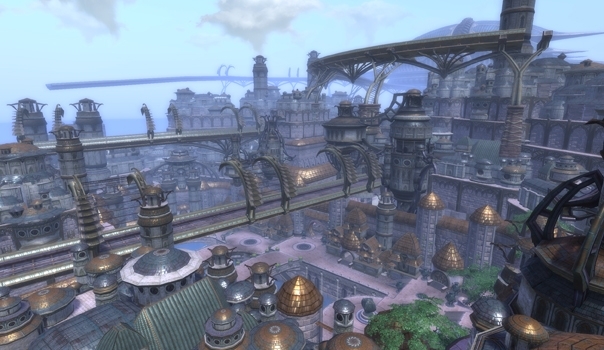Storm Legion - Class Roundtable with Gersh
Adam 'Gersh' Gershowitz shares the secrets of Souls in a roundtable discussion with Rift community members. Plus join in our Storm Legion Beta Giveaway!

Pre-expansion, some Synergy Crystals were class-defining. Some specs needed certain Crystals, and became very strong. Is the same approach being used in Storm Legion?
Gersh: If you’ve played 1.11, you’ll see that we’ve made some changes to synergy crystals. I think the most important change we made is the fact that the original synergy crystals weren’t necessarily forward looking, so some were fairly class defining. And the way that they were class defining is that their bonuses would scale indefinitely.
I think the biggest thing you’re going to find with Synergy Crystals in general is that we still want them to be really good, powerful bonuses, which may be geared toward one build or another. That way we can do a large variety of them. But what you’ll find is that they’re going to be a little less all-encompassing, when you get bonuses. They’ll be more of a fixed power value, and not necessarily a percent to all of everything. That way, we don’t have a situation where people go ‘Hey, I got this Synergy Crystal back in the classic game, and I’m going to carry it through all of Storm Legion and never get rid of my items, because this bonus is just that good.’
A lot of the changes we’ve made to Synergy Crystals address things like that. We still, conceptually, want to have really solid bonuses – a calling defining bonus early on, some stats for players, and then something that’s a little more class specific at the top end. We don’t want to make them as much where you’re in a hardcore guild; you need exactly this spec, this build, with this Synergy Crystal. But at the same time, we want items like that to be sought out by players, because they have a particular play style and they make it better.
Spell reflection and crowd control immunity often don’t work on raid bosses. Any plans to reduce this?
Gersh: That’s a careful dance between our class designers and our encounter designers. Ultimately, there are certain abilities that are just really fun to use, and they’re designed for everyday use. But when it comes down to a very tightly tuned encounter, the overpowered-ness of being able to reflect a spell or completely avoid a hit is an order of magnitude better than when you’re fighting a normal monster.
We tried our best to make sure those work better with our encounters. We have a better knowledge of our classes now and how players play them, we have a better knowledge of how players play our encounters and which encounters are more enjoyable than others. So, overall, I think you’re going to find that there are still going to be some abilities out there that just aren’t going to work in certain encounters, but there’ll be other encounters throughout the dungeons and raids that may actually take advantage of that.
Even if we have to shut it off on certain things, there may be situations where we want to make sure that, as part of the tactic for this encounter, you can reflect the spells. But it’s going to be on a boss-by-boss basis, mainly based on what our goals are for the boss, and how we want to make it difficult, or easy, or challenging.
The Dominator is dependent on some abilities that don’t work in raids. Will they become more viable?
Gersh: I’m not 100% sure what the answer is, because I don’t know exactly what our guys are doing in that regard, but I do know that we have gone back and disconnected certain pieces of failure. We have done a number of things where ‘Hey, if this spell is successful you get this type of buff. If the monster is immune to it, the positive benefit may go off on you, but not actually do the negative benefit on the monster.’ I do know that for classes like the Dominator, and other support classes, we have done things to try and make those classes are a little bit more acceptable where certain things happen in an encounter.
To go back to the Chloromancer, this is actually a really big reason why we dissociated damage and healing. One of the Chloromancer’s greatest strengths was the higher damage was, the more healing he did. But one of the greatest weaknesses was, in any type of encounter where we reduced damage, or the mob got a damage absorbing shield on them, or where he goes into a berserk mode where he takes less damage and deals more, the Chloromancer immediately became an unviable healer. That’s one of the reasons why we started dissociating some of those things.
Why can we no longer stack mana regeneration?
Gersh: In concept, stacking mana regen was a really great idea. In practice, the way that we had mana balanced, especially with the Mages and Clerics balanced differently, it just didn’t play out very well. Also, the way that mana regeneration was growing with the way items worked, it made it very difficult to make some encounters more difficult, because if people never ever run out of resources, then that’s a condition for us where it’s very hard to make sure the tank dies, or very hard to try and overwhelm a group of people.
When we went back and looked at mana, we said ‘well what’s the more fun thing?’ The more fun thing is to have a larger bar, and be able to cast spells for a longer period of time. Running out of mana is not necessarily fun, and people are doing everything they can to counteract that. So we wanted to put people at a good sized mana bar, where they had plenty of time to hit the ‘fun button’ as we call it, for a good length of time. But in extended situations, like a longer raid or dungeon encounter, they would eventually have to manage their mana a little more and restore it.
That comes back to part of the reason why we’ve done a lot more on mana restores for those mana classes. So the situation is ‘I’m healing, I’m healing, I’m healing’, or ‘I’m dealing damage, I’m dealing damage’, and eventually I’m going to hit the end of my bar, but it’s not hard for me to get enough back so that I can keep going. I can use an ability or chug a potion real quick, but there is a slight time delay there.
For most players, they‘re not going to notice it. For me, or hardcore raiders, or people in dungeons, that split second, that one or two cooldown where you have to get mana back, could make the difference between completing or not completing the encounter. So we really wanted to make it more global between our Mages and our Clerics, easier to understand, and a little less exploitable in the fact that in order to get round those encounters, the tactic was to just get a ton of mana regen.
Everyone is looking at the Bard and Tactician, now that they can cast while moving. Any plans to give more mobility to other classes?
Gersh: The Bard is a bit more of a unique situation. In general we are improving mobility in a lot of classes. It is difficult to make a class extraordinarily mobile, and then also be an extremely good healer or an extremely good damage dealer, because the end result is, when it comes back to anything like encounter design, there needs to be some levels of trade-off.
With the Bard in particular, part of the reason why we can make them more mobile, is because they’re designed to be a support class. They aren’t the best DPS in the raid, they aren’t the best healers in the raid, they do need to move between locations a lot, a lot of their buffs are area effect based, a lot of their effects are shorter ranged or more difficult to use. So the extra mobility there makes up for the fact they aren’t necessarily the best DPS class, the best healing class.
As a jack of all trades support class, they benefit from having mobility, a little bit of DPS, a little bit of healing, a lot of buffing. That’s something that’s a little bit more unique to them. At the same time, you’ll see across a lot of our souls or classes, there are a lot of abilities that give players a few more mobility options. They may not be the best option in particular situations, but they are there.
Next Up: Rogue Tanks and Test Dummies on Page 3 ->




